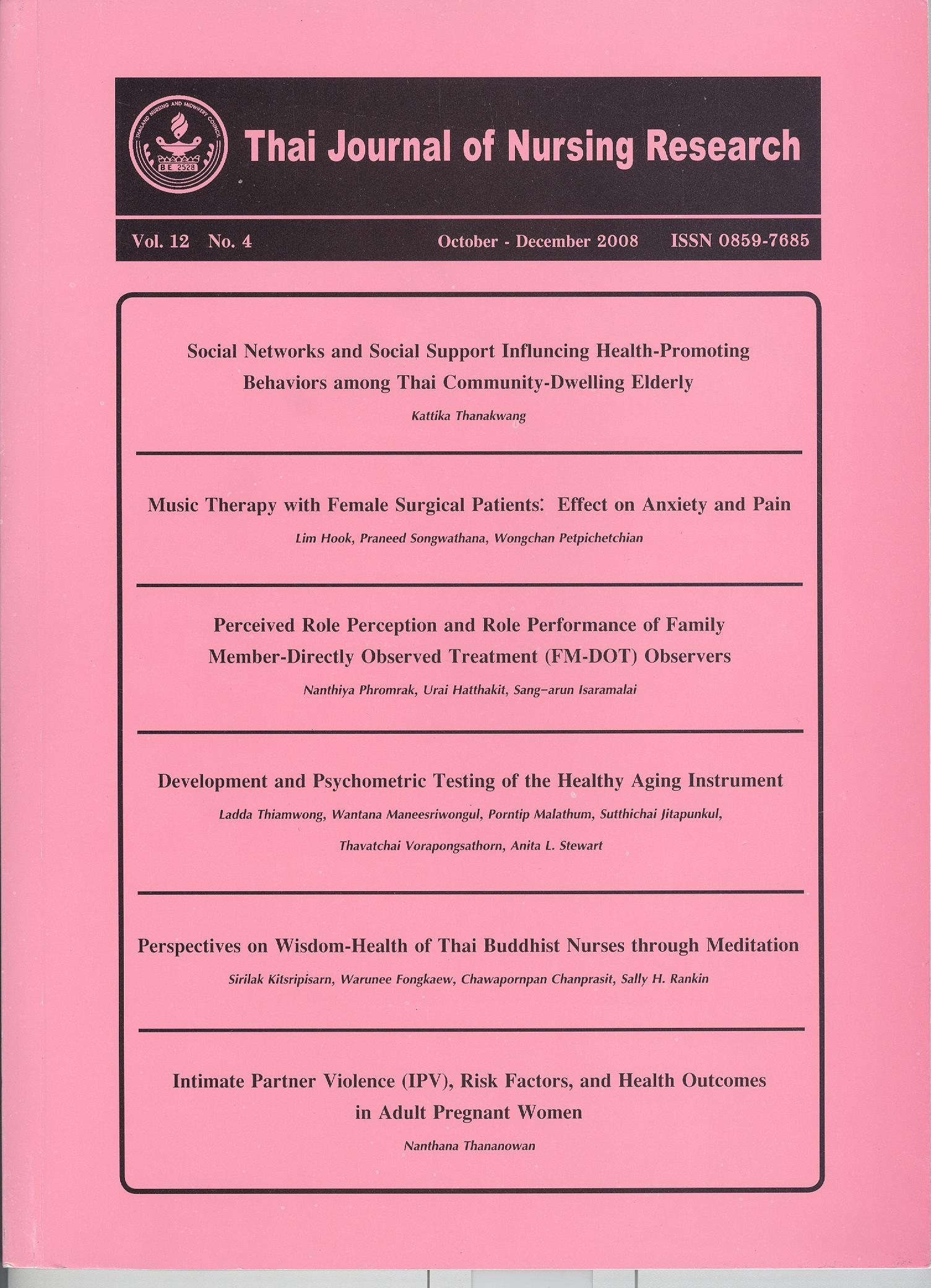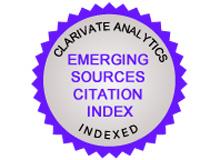Development and Psychometric Testing of the Healthy Aging Instrument
Keywords:
ผู้สูงอายุไทย, การสูงวัยอย่างมีสุขภาวะ, การพัฒนา, เครื่องมือ, ทดสอบคุณสมบัติเครื่องมือAbstract
บทคัดย่อ
การศึกษานี้มีวัตถุประสงค์เพื่อพัฒนาและทดสอบคุณสมบัติของเครื่องมือประเมินการสูงวัยอย่างมีสุขภาวะ ซึ่งเป็นเครื่องมือที่มีองค์ประกอบหลายมิติเพื่อใช้ในการประเมินกระบวนการของการสูงวัยอย่างมีสุขภาวะในบริบทของผู้สูงอายุไทย ข้อคำถามถูกพัฒนามาจากผลการสนทนากลุ่มและสัมภาษณ์รายบุคคล เครื่องมือนี้ผ่านการทดสอบความตรงเชิงเนื้อหาจากผู้เชี่ยวชาญจำนวน 5 ท่าน พบว่า มีค่าดัชนีบ่งชี้ความตรงเชิงเนื้อหาสูง และได้ทดสอบความยากง่ายและความเข้าใจของคำถามในผู้สูงอายุ 10 ราย หลังจาก pretest เครื่องมือนี้ประกอบด้วยคำถาม 46 ข้อ
เครื่องมือนี้ได้รับการทดสอบความตรงเชิงโครงสร้างและความเชื่อมั่น โดยเก็บข้อมูลในผู้สูงอายุในจังหวัดหนึ่งของภาคใต้ จำนวน 403 ราย ค่าความตรงเชิงโครงสร้างตรวจสอบโดยวิธี Principle Component Analysis หมุนแกนโดยวิธี Varimax และมีค่า Factor loading มากกว่า .40 ขึ้นไป พบว่าได้ 9 ปัจจัย โดยมีข้อคำถาม 35 ข้อ ได้แก่ 1) การใช้ชีวิตเรียบง่ายและพอประมาณ 2) การจัดการกับความเครียด 3) การมีสัมพันธภาพที่ดีและได้รับการสนับสนุนจากคนในครอบครัวและเพื่อนบ้าน 4) การทำบุญและทำความดี 5) การตระหนักรู้และดูแลตนเอง 6) การไม่อยู่นิ่งเฉยด้านกาย 7) การบริหารความคิด 8) การมีปฏิสัมพันธ์กับสังคม และ 9) การยอมรับการสูงวัย โดยทั้ง 9 ปัจจัยนี้ สามารถร่วมอธิบายความแปรปรวนของการสูงวัยอย่างมีสุขภาวะ ได้ร้อยละ 62 และมีค่าความเชื่อมั่นชนิดสอดคล้องภายในของแต่ละปัจจัย .69 ถึง .80 และความเชื่อมั่นชนิดความสอดคล้องภายในของทั้งเครื่องมือ .88
เครื่องมือนี้มีค่าความตรงเชิงเนื้อหา ความตรงเชิงโครงสร้าง และความเชื่อมั่นชนิดความสอดคล้องภายในที่ดีและยอมรับได้ นอกจากนี้ เป็นเครื่องมือที่ใช้ง่าย สามารถใช้เวลาตอบ 15 นาที เครื่องมือนี้พัฒนาเป็นครั้งแรก คาดว่าจะเป็นประโยชน์ต่อการประเมินกระบวนการสูงวัยอย่างมีสุขภาวะที่มีความเหมาะสมกับผู้สูงอายุไทย เนื่องจากเครื่องมือนี้สร้างในบริบทของผู้สูงอายุในจังหวัดหนึ่งของภาคใต้ ดังนั้น ในการนำไปใช้ควรพิจารณาความเหมาะสมด้านความแตกต่างทางวัฒนธรรมและบริบท
คำสำคัญ : ผู้สูงอายุไทย การสูงวัยอย่างมีสุขภาวะ การพัฒนา เครื่องมือ ทดสอบคุณสมบัติเครื่องมือ
Abstract
The purpose of this study was to develop, refine, and evaluate the psychometric properties of the Healthy Aging Instrument (HAI). The HAI is a multidimensional instrument that attempts to measure the process of healthy aging in a Thai context. Themes emerged from focus groups and in-depth interviews, which were used to develop an item pool. The HAI was reviewed for content format by five experts and for clarity and readability by 10 older adults. The content validity index among the experts was high. After the pretest, the HAI consisted of 46 items.
To test construct validity and internal consistency, the HAI was completed by 403 Thai older adults in a Province of Southern Thailand. Evaluation of construct validity through principal component factor analysis with varimax rotation and using factor loading greater than .40 yielded 9 factors and 35 items: 1) Being Self-Sufficient and Living Simply, 2) Managing Stress, 3) Having Social Relationships and Support, 4) Making Merit and Good Deeds, 5) Practicing Self-Care and Self-Awareness, 6) Staying Physically Active, 7) Staying Cognitively Active, 8) Having Social Participation, and 9) Accepting Aging, which jointly explained 62% of the variance in the process of healthy aging. Cronbach’s alpha for each of the subscales ranged from .69 to .80 and the overall HAI was .88.
The HAI demonstrated adequate internal consistency reliability and showed evidence of content and construct validity. The instrument requires less than 15 minutes on average to administer and had no item-level missing data rates. These findings suggest that the HAI adequately captures a newly identified construct and should be useful for investigators to measure healthy aging in a Thai context. However, the HAI was developed from older adults only in a province of Southern Thailand, thus, the issue of culture and context should be considered for implication of this instrument.
Key words: Thai older adults, healthy aging, development, instrument, psychometric testing
Downloads
How to Cite
Issue
Section
License
Copyright: The Pacific Rim International Journal of Nursing Research, Thailand Nursing & Midwifery Council has exclusive rights to publish, reproduce and distribute the manuscript and all contents therein.








.png)



